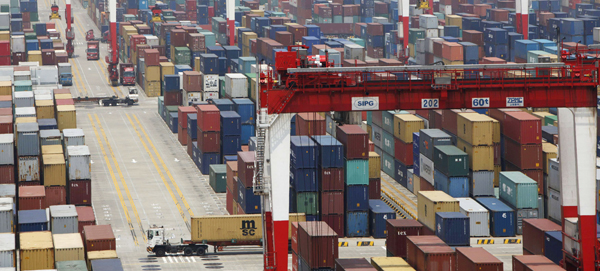Understanding emerging markets

A shipping container area at Yangshan Port in Shanghai in 2012. China’s inflation, industrial output and retail sales all flagged in a sharpening slowdown. [REUTERS/NEWS1]

Jim O´Neill
1. The emerging economies are more different from one another than they are alike. China is bigger than Germany, France and Italy combined, even in current dollar terms. On the basis of new purchasing-power-parity estimates, China might already be as big as the United States. South Korea is as rich as Portugal and not far behind Spain: It has plenty in common with those “advanced economies” and nothing in common with the “emerging markets” of Africa.
2. The mood of the markets is sometimes good for a laugh, but not much else. At one of the conferences, I was assigned this question: “Is this emerging-market crisis going to be as bad as 1998?” This was in March. For the year to date, with the important exceptions of the Chinese and Russian markets, virtually all emerging-market equity indices are showing stronger gains than the United States, many of them at double-digit rates.
3. Let’s stop supposing that the advanced economies can have a good recovery while the rest fall back - let alone fall as far as they did in 1998. In differing degrees, the United States, Europe and Japan all need to export their way to a full recovery from their post-2008 doldrums. If their export markets in Asia and Latin America collapse, that won’t happen. The idea that the developed world is back while the emerging-market economies are in trouble doesn’t add up.
4. Let’s stop talking down China’s economic strength. Many complain that its official statistics are inflated: Partly, I think, this reflects the belief (or hope) that a nondemocratic country is bound to fail. Skilled China watchers are appropriately skeptical and look at other indicators as well. They find that China’s growth is no illusion. Bear in mind, too, that China’s government resisted the new PPP revisions because they showed the economy to be larger than the authorities want to acknowledge (for purposes of development assistance and global obligations).
5. Relatedly, the global economy is doing better than many suppose. Thanks to China and other large emerging economies, growth in global gross domestic product will approach 4 percent a year over the course of this decade, according to the International Monetary Fund - higher than in either of the previous decades. The new PPP data suggest that the world economy is growing even faster than the conventional measures suggest: Even at a supposedly slow rate of 7 percent, China will contribute more than twice as much as the U.S. to this year’s rise in global output.
6. Much of China’s slowdown is deliberate, part of an effort by China’s government to shape a more sustainable and balanced economy.
7. China’s slowdown will help some and hurt others. Countries such as Australia and Brazil are probable losers because they depend on exports of commodities. India and Mexico are probable winners because rising Chinese wages will help their competitiveness.
8. Don’t confuse doing the right thing with being lucky. Many emerging economies have done well during the past 10 years because of China’s boom and United States’s benign monetary policy, not because of good policy at home. Recognizing the importance of outside forces underlines the need for resilience - because external factors can easily become less benign.
9. Be careful with labels like “fragile five.” The term was coined for Brazil, India, Indonesia, South Africa and Turkey. Equities in India and Indonesia are up around 15 percent for the year to date, reflecting better performance and hope for better policy. Turkey, despite everything, is up 12 percent. Even with Brazil and South Africa showing more modest gains, “fabulous” might have made more sense than “fragile.” Certainly there were far worse places to invest - such as Japan, persistently praised by analysts and down 15 percent. Of the 15 most populous emerging economies, only China, Mexico and Russia are showing negative performances for the year to date.
10. Always look to these factors: market valuation; cyclical prospects; structural barriers and opportunities; and the outlook for policy above all. Granted, low-income economies such as India and China have opportunities for catch-up growth that the United States doesn’t, but aside from that, it doesn’t much matter whether an economy is “emerging” or “advanced.” Don’t let those terms be a substitute for thinking about what counts.
*The author, former chairman of Goldman Sachs Asset Management, is a Bloomberg View columnist.
By Jim O’Neill










with the Korea JoongAng Daily
To write comments, please log in to one of the accounts.
Standards Board Policy (0/250자)